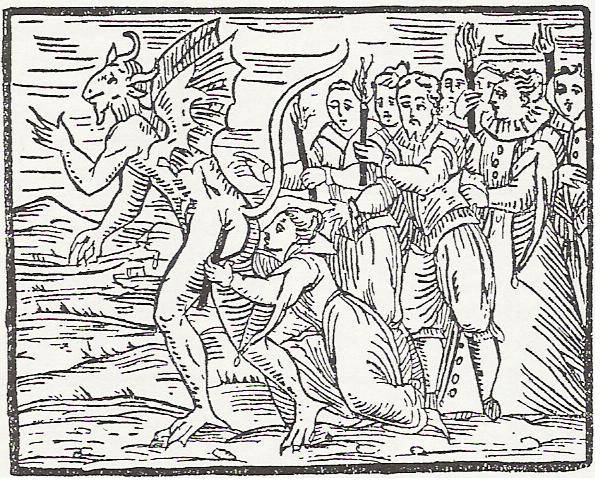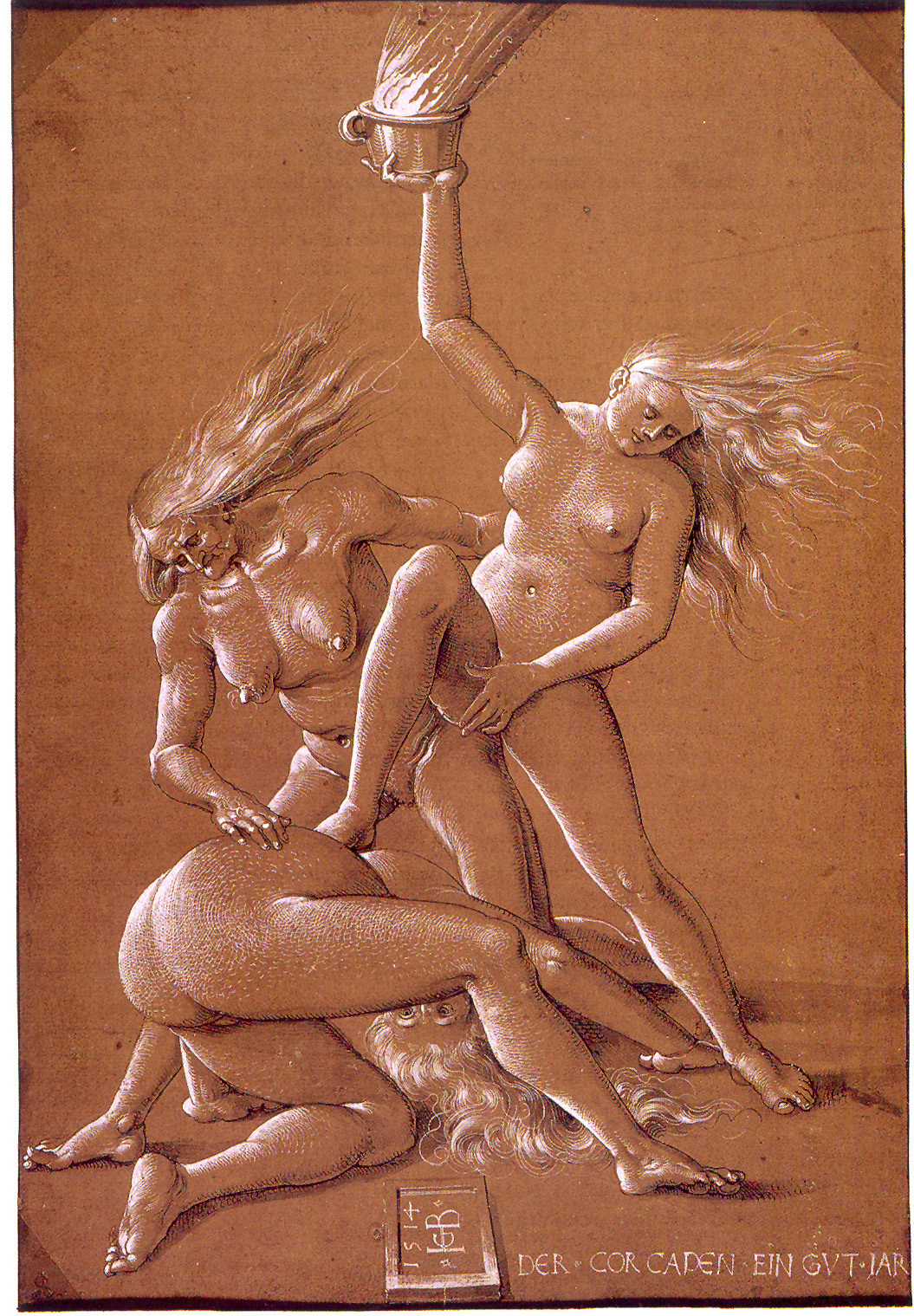
Wikimedia Commons
Osculum infame, also known as the Kiss of Shame, the Obscene Kiss, or the translation from Latin of the Infamous Kiss, is the name commonly given to the ritual of a witch paying homage to the Devil by kissing him. Usually performed at a gathering of witches, the Devil would assume the appearance of an animal, often a goat or a cat, then his adherents would kiss his genitals, anus or feet. Although most accounts of the kiss appear during the period of the witch trials, its origins can be traced back to literature of heretic hunters from the Middle Ages; associations have also been made to the late second-century treatise, Octavius.
Allegations of the performance of the osculum infame were included in charges against groups such as the Cathars, the Waldensians and the Knights Templar.
History
The roots of the kiss might extend as far back as the late second century;[a]There is debate among scholars as to the exact publication date of Octavius but most accept 197. in Octavius, Minicius Felix describes the Christian veneration of a donkey’s head and their reverence to a priest’s genitals. In the Roman Empire, Jews and conspirators faced similar accusations.[1]
A twelfth-century account of heretics holding clandestine meetings describes how a demonic black catThe numerous folk beliefs about black cats, and cats in general, are often contradictory. Superstitions surrounding black cats are almost certainly some of the most prevalent even today, along with the number thirteen and walking under a ladder. was kissed on the genitals, beneath the tail and on the feet. Demons in the shape of cats and toads receiving kisses on their rumps and mouths as a form of worship from heretics were included in the works of William of Auvergne, a scholastic philosopher from medieval times.[2] Propaganda documents against the Cathars[b]Cathars were an active European group from the tenth to the fourteenth century that the Catholic Church designated as witches.[3] and the Waldensians[c]Waldensians were a group of heretics established in the twelfth century. They were active until around the fifteenth century, by which time witchcraft was referred to in France as Waldensianism or Vauderie.[4] carried details of the Devil as the recipient of the self-abasing homage.[1]
The charges brought against the Knights Templar[d]Established between 1119–1188[5] the Knights Templar are described by scholar Malcolm Barber as “one of the most powerful monastic orders in Christendom”.[6] They had become very wealthy but, after the events initiated in 1307, by 1314 the dissolution of the Templars was complete.[7] by King Philip IV in 1307 included that postulants were required to perform the osculum infame. During the ceremony the master would be kissed on the mouth, navel, posterior or genitals by the naked postulant; the ritual could also be reversed with the postulant being the recipient instead.[8] A further charge was that they kissed the anus of a Satanic cat.[9] Of the 138 confessions given under duress that survive from the trials held in Paris, only four did not fully admit the charges presented;[10] seventy-five per cent admitted some form of indecent kissing had been performed at their initiation ceremony.[11]
Witch trials

Wikimedia Commons
Despite its long history, most accounts of osculum infame appear during the period of the witch trials.[12] Interpreted as a sign by which a witch was worshipping and paying homage to the Devil, accounts of some variation of the kiss feature in the majority of descriptions of gatherings of witches included in confessions, many of which were obtained by torture.[13] Although most common in Europe, no illustrations of it exist in the publications of English persecutions, possibly as torture was not regularly employed in the questioning of those accused. The pamphlet, Newes from Scotland1591 pamphlet describing the North Berwick witch trials in Scotland, detailing the confessions given by the accused witches before the King., published in 1591, provided the first descriptions of the osculum infame to the English population.[14] Covering details of the North Berwick witch trialsSeries of Scottish witch trials held between 1590 and 1593. , Newes chronicles the Kiss as being demanded by the Devil as a penance for witches being late for a meeting.[5]
The Malleus maleficarum – a treatise published in 1486 that was pivotal in the pursuit of witches[15] – contains only a tangential reference to the Kiss. The authors were unsuccessful in securing a case against a suspected witch who at the end of a blessing given during a Mass added the phrase “Give me the tongue in the arse”.[9][e]In German: “Kehr mir die Zung im Arss umb”[16]
The Kiss is generally regarded as an act of degradation; at the start of a witches’ meeting, the Devil would register the names of those present who would then each draw close to him – by crawling on their hands and knees or walking backwards – turn, bow and kiss his buttocks. It also formed part of a witches’ initiation ceremony. The banquet and merriment would then start. Occasionally the same homage had to be shown to demons of a lower status;[5] the role could also be reversed whereby the witch was the recipient of the kiss.[9]
Modern interpretations
Twenty-first century scholars such as Jonathan Durrant describe the osculum infame as “a parody of the kiss of peace in the Christian Eucharist”. It also provided an indicator of unacceptable sexual practices and furnished evidence of dishonourable behaviour.[17]
The French theologian Alain de Lille wrote in his tract Against the heretics of his times[f]Published some time between 1179 and 1202[18] that the name of the Cathars was derived from the Low Latin cattus or “cat” because the Devil appeared to the sect in that form to receive the obscene kiss. According to academic Norman Cohn that etymology was commonly accepted, but he adds that de Lille also included the correct version: “the name comes from the Greek Katharoi, ‘the pure ones’ ”.[19] A similar conclusion is reached by scholar, Jeffrey Burton Russell, who refers to de Lille’s cattus etymology as “one of the more amusing etymological blunders of the period”.[20]
Russell suggests the Kiss may denote a “kind of dark communion, an eating of the god, a total taking into oneself of the Devil.” He also considers it may have been an indirect reference to the Judas Kiss and a repudiation of Christianity.[21] In the case of the Knights Templar, he suggests that the aim of soliciting confessions of the performance of the Kiss was to augment the charges of homosexuality made against them;[22] academic Julian Goodare asserts: “There was no truth in the accusations”.[7]
Several illustrations show demons with another face on the buttocks – the depositions of some witches from Savoy include admissions that they had kissed the second face of the Devil.[23] The Kiss is a prominent feature in confessions from Basque witches; as a part of their initiation ceremony they were required to place a kiss below his tail and on his genitals.[24] The court records of the witches tried in Eichstätt, however, contain hardly any references to the Kiss, which may be a reflection that, despite being subjected to torture, the alleged witches in Eichstätt would not allow themselves to be branded as dishonourable.[25]
Records of witchcraft trials held between 1438 and 1528 in and around Lausanne indicate that the inquisitors used a fairly fixed set of leading questions when interrogating suspects. Routinely asked in the same sequence each time, the confessions tended to follow the same sequential order. One of the matters raised at the onset of these formulaic examinations concerned the witch paying homage to the Devil by performing acts such as the obscene kiss. This methodology generally achieved responses with the descriptions closely resembling each other.[26]
Notes
| a | There is debate among scholars as to the exact publication date of Octavius but most accept 197. |
|---|---|
| b | Cathars were an active European group from the tenth to the fourteenth century that the Catholic Church designated as witches.[3] |
| c | Waldensians were a group of heretics established in the twelfth century. They were active until around the fifteenth century, by which time witchcraft was referred to in France as Waldensianism or Vauderie.[4] |
| d | Established between 1119–1188[5] the Knights Templar are described by scholar Malcolm Barber as “one of the most powerful monastic orders in Christendom”.[6] They had become very wealthy but, after the events initiated in 1307, by 1314 the dissolution of the Templars was complete.[7] |
| e | In German: “Kehr mir die Zung im Arss umb”[16] |
| f | Published some time between 1179 and 1202[18] |
